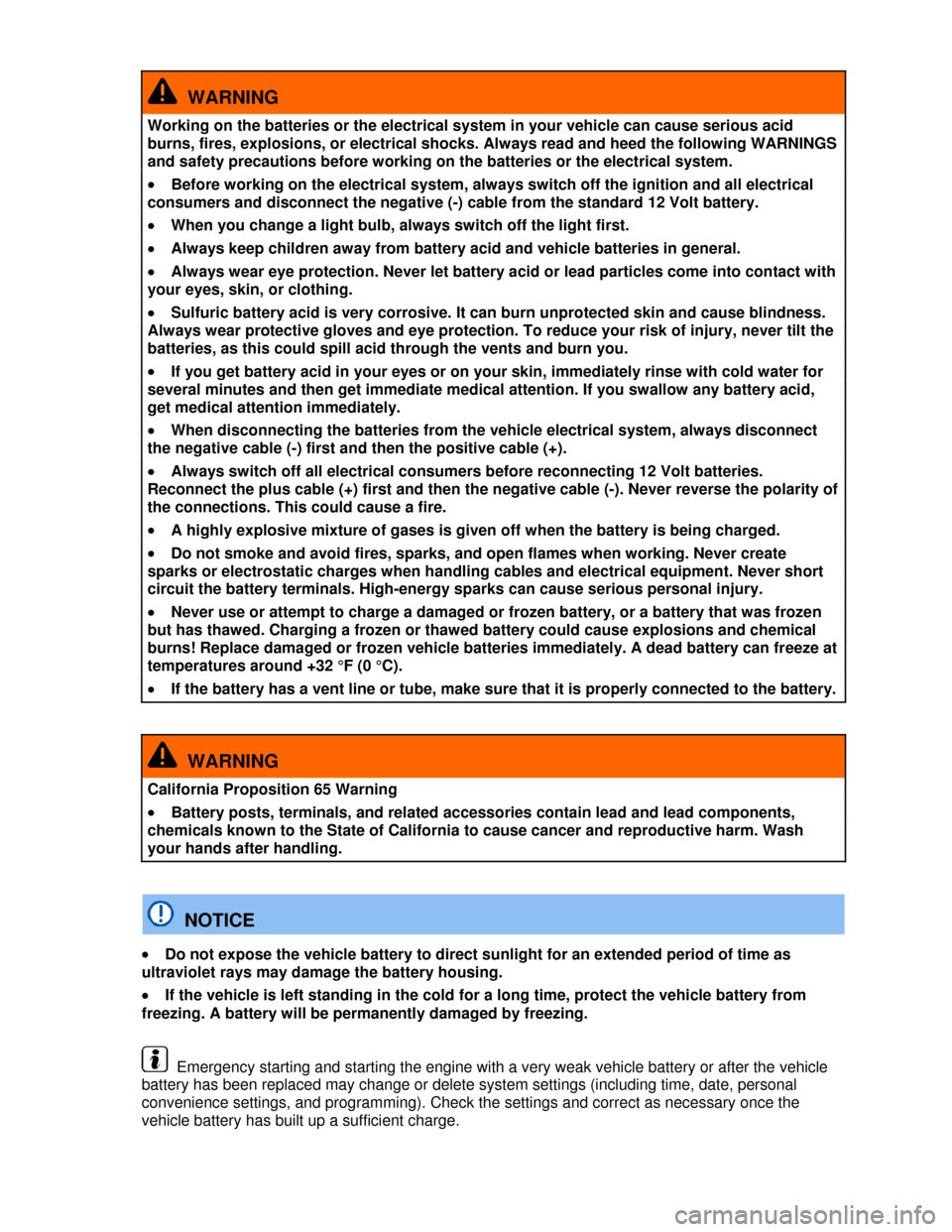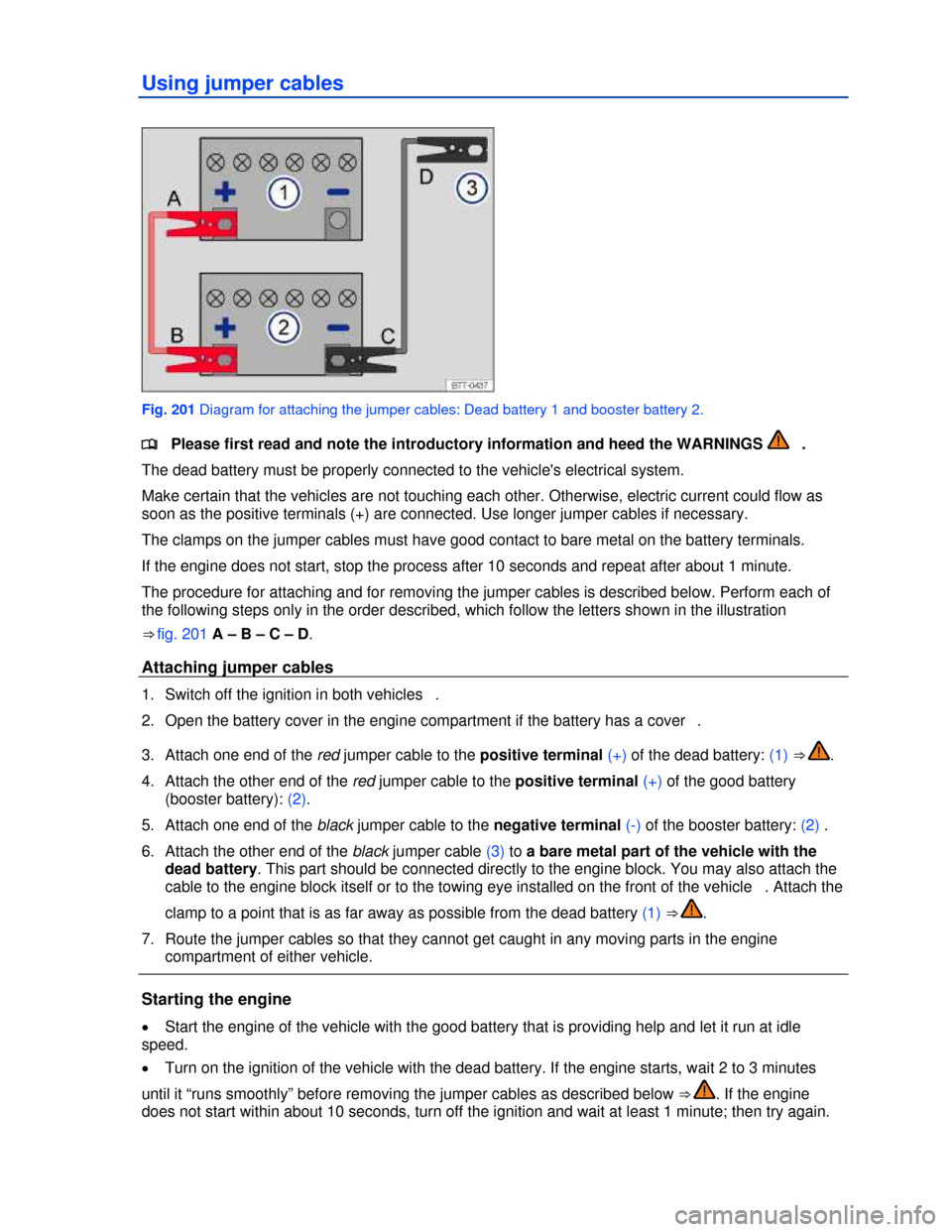2013 VOLKSWAGEN JETTA SPORTWAGEN dead battery
[x] Cancel search: dead batteryPage 46 of 324

Convenience features
To use the convenience closing feature to close all power windows and the sunroof, hold your finger
on the lock sensor surface on the outside of the door handle for a few seconds until the windows and
sunroof close.
Remove your finger from the lock sensor surface ⇒ fig. 27 (B) to stop the function. If you touch the
unlock sensor surface (A) on the inside of the door handle immediately after releasing the lock sensor
surface (B) (arrow), all of the windows will open (safety function).
Pinch protection is active during convenience closing of the windows and the power sunroof.
The settings in the Settings – Convenience menu determine which doors open when the door
handle unlocking surface is grasped.
NOTICE
The door handle sensor surfaces can be activated by a strong stream of water or steam if a
valid vehicle key is within range of the vehicle.
�x All windows may open if you turn the spray of water or steam away from and then back onto
the door handle sensor surface in quick succession. If at least one power window is opened
and the sensor is continuously activated, convenience closing is started.
The door may not open if the outside and inside door handles are used at the same time.
If the vehicle battery or the battery in the remote control vehicle key is weak or dead, it might not
be possible to unlock and lock the vehicle using Keyless Access. The vehicle can still be manually
locked or unlocked with the key bit .
The driver message Key not in range appears in the instrument cluster display if there is no
remote control vehicle key inside the vehicle or if the system does not recognize the remote control
vehicle key. The key may not be recognized, for example, if it is covered by something that interferes
with the signal (such as a briefcase), or if the remote control vehicle key battery is weak. Electronic
devices such as cell phones can also interfere with the signal.
Dirt on the door handles that contains a lot of salt (especially in winter) can affect the way the
door handle sensors work. Cleaning the door handles can help with this problem .
If the automatic transmission is not in Park (P) position, the electronic steering column lock will
not lock and the vehicle will not lock via sensors in the front door handles or the remote control vehicle
key.
Anti-theft alarm system
�
Page 47 of 324

The anti-theft alarm system is automatically activated when the vehicle is locked by pressing the lock
button on the remote control vehicle key.
When is the alarm triggered?
The anti-theft alarm system sounds for about 30 seconds and the turn signals flash for up to 5 minutes
if the following occurs with respect to the locked vehicle:
�x Opening a door that has been mechanically unlocked.
�x Forcibly opening a door.
�x Forcibly opening the engine hood.
�x Forcibly opening the rear hatch.
�x Switching on the ignition with an invalid key.
�x Disconnecting the vehicle battery.
Deactivating the alarm
Unlock the vehicle with the unlock button on the remote control vehicle key or switch on the ignition
with a valid vehicle key.
For vehicles with Keyless Access, the alarm can be deactivated by grasping one of the front door
handles when a valid vehicle key is in range or by holding the remote control vehicle key to the right of
the steering column trim and pressing the starter button
After the alarm has stopped and the vehicle is opened again in the same or a different area that
is protected by the alarm, the alarm is triggered again. For example, the alarm will sound again if the
rear hatch is opened after one of the doors has been opened.
The anti-theft alarm system is not activated when the vehicle is locked with the power lock
switch W on the inside of the driver or front passenger doors.
If the driver door is mechanically unlocked using the vehicle key bit, only the driver door is un-
locked, not the entire vehicle. Switching on the ignition deactivates the anti-theft alarm system and
activates the central locking button. To unlock the doors, use the central locking button or remote
control vehicle key.
If the vehicle battery is dead or weak, the anti-theft alarm system will not work properly.
Page 247 of 324

WARNING
Working on the batteries or the electrical system in your vehicle can cause serious acid
burns, fires, explosions, or electrical shocks. Always read and heed the following WARNINGS
and safety precautions before working on the batteries or the electrical system.
�x Before working on the electrical system, always switch off the ignition and all electrical
consumers and disconnect the negative (-) cable from the standard 12 Volt battery.
�x When you change a light bulb, always switch off the light first.
�x Always keep children away from battery acid and vehicle batteries in general.
�x Always wear eye protection. Never let battery acid or lead particles come into contact with
your eyes, skin, or clothing.
�x Sulfuric battery acid is very corrosive. It can burn unprotected skin and cause blindness.
Always wear protective gloves and eye protection. To reduce your risk of injury, never tilt the
batteries, as this could spill acid through the vents and burn you.
�x If you get battery acid in your eyes or on your skin, immediately rinse with cold water for
several minutes and then get immediate medical attention. If you swallow any battery acid,
get medical attention immediately.
�x When disconnecting the batteries from the vehicle electrical system, always disconnect
the negative cable (-) first and then the positive cable (+).
�x Always switch off all electrical consumers before reconnecting 12 Volt batteries.
Reconnect the plus cable (+) first and then the negative cable (-). Never reverse the polarity of
the connections. This could cause a fire.
�x A highly explosive mixture of gases is given off when the battery is being charged.
�x Do not smoke and avoid fires, sparks, and open flames when working. Never create
sparks or electrostatic charges when handling cables and electrical equipment. Never short
circuit the battery terminals. High-energy sparks can cause serious personal injury.
�x Never use or attempt to charge a damaged or frozen battery, or a battery that was frozen
but has thawed. Charging a frozen or thawed battery could cause explosions and chemical
burns! Replace damaged or frozen vehicle batteries immediately. A dead battery can freeze at
temperatures around +32 °F (0 °C).
�x If the battery has a vent line or tube, make sure that it is properly connected to the battery.
WARNING
California Proposition 65 Warning
�x Battery posts, terminals, and related accessories contain lead and lead components,
chemicals known to the State of California to cause cancer and reproductive harm. Wash
your hands after handling.
NOTICE
�x Do not expose the vehicle battery to direct sunlight for an extended period of time as
ultraviolet rays may damage the battery housing.
�x If the vehicle is left standing in the cold for a long time, protect the vehicle battery from
freezing. A battery will be permanently damaged by freezing.
Emergency starting and starting the engine with a very weak vehicle battery or after the vehicle
battery has been replaced may change or delete system settings (including time, date, personal
convenience settings, and programming). Check the settings and correct as necessary once the
vehicle battery has built up a sufficient charge.
Page 290 of 324

Frequently asked questions
If you suspect a malfunction or vehicle damage, read and follow the following advice before contacting
an authorized Volkswagen dealer or an authorized Volkswagen Service Facility. You may also find
helpful information under “Special considerations” or “Checklist” in the index.
Description Possible causes, among
others Possible remedy
Engine does not start. Vehicle battery dead. – Perform jump-start .
– Charge vehicle battery .
The wrong vehicle key is used. Use a valid vehicle key
Fuel level too low. Refuel .
Vehicle cannot be locked
or unlocked using vehicle
key.
– Battery in the remote control
vehicle key is dead.
– Too far away from the
vehicle (out of range).
– Buttons have been pressed
too many times.
– Replace the battery in the remote
control vehicle key
– Move closer to vehicle.
– Synchronize vehicle key
– Lock or unlock vehicle manually .
Unusual noises. Cold engine, braking assist
systems, electronic steering
column lock.
Check the “Noises” entry in the index.
Odd driving behavior. Assistance systems activated. Check the “Assistance systems” entry
in the index.
DSG® Direct Shift Gearbox too
hot.
Stop vehicle as soon as you can safely
do so.
Front seats cannot be
adjusted with power
controls.
Vehicle battery dead. Charge vehicle battery .
Fuse blown. Check fuse and replace if necessary .
Features do not work as
described in this manual.
Settings were adjusted in the
Volkswagen Information
System.
Check and reset to factory settings if
necessary
Headlights do not light up
the road as they should.
– Headlights incorrectly
adjusted.
– Light bulbs burned out.
– Low beams not switched on.
– Have the headlight range adjusted by
an authorized Volkswagen dealer or an
authorized Volkswagen Service
Facility.
– Change light bulbs .
– Switch on low beams
Electrical consumers do
not work.
Vehicle battery charge too low. Charge vehicle battery .
Remaining fuel level too low. Refuel .
Fuse blown. Check fuse and replace if necessary .
Fuel consumption higher
than indicated.
– Short hauls.
– “Jumpy” accelerator pedal.
– Avoid short distance driving.
– Drive defensively.
– Accelerate smoothly.
Electrical loads switched on. Switch off unnecessary loads.
Engine control malfunction. Have the malfunction corrected .
Tire pressure too low. Adjust tire pressure .
Page 316 of 324

WARNING
Improper use of jumper cables when jump-starting a vehicle with a dead battery can cause
the battery to explode, leading to serious personal injury. To help reduce the risk of battery
explosion:
�x All work on the batteries or the electrical system in your vehicle can cause serious acid
burns, fires, or electrical shocks. Always read and heed the following WARNINGS and safety
precautions before working on the batteries or the electrical system , Vehicle battery.
�x Always make sure that the battery providing starting assistance (the booster battery) has
the same voltage as the dead battery (12 V) and about the same amperage capacity (see
battery label).
�x Never jump-start a vehicle with a thawed or frozen vehicle battery. The battery can
explode. A dead battery can freeze at temperatures around +32 °F (0 °C).
�x A battery that is frozen or was frozen, but has since thawed, must be replaced.
�x When the vehicle battery is jump-started, it gives off hydrogen gas, which is highly
explosive! Always keep fire, sparks, open flame, and smoking materials far away from vehicle
batteries. Never use a cellular telephone while connecting or disconnecting jumper cables.
�x Jump-start batteries only in well-ventilated areas. Batteries give off highly explosive
hydrogen gas during jump-starting.
�x Always route the jumper cables so that they cannot get caught in any moving parts in the
engine compartment.
�x Never short out the battery terminals by connecting the positive (+) and negative (-)
terminals with each other.
�x Never connect the negative cable from the other vehicle directly to the negative terminal
of the dead battery, as this may cause the hydrogen gas given off by the dead battery to
explode.
�x Never attach the negative cable from the vehicle providing starting assistance to any part
of the fuel system or to the brake hoses or brake lines.
�x Never allow the non-insulated parts of the battery clamps to touch.
�x Never allow the jumper cable attached to the positive battery terminal to contact metal
parts of the vehicle.
�x Always follow the instructions of the jumper cable manufacturer.
NOTICE
To help prevent extensive damage to the vehicle electrical system, read and heed the
following:
�x Connecting jumper cables improperly can cause a short circuit and do expensive damage
to the vehicle's electrical system.
�x Do not let the vehicles touch each other while the jumper cables are connected. If they do,
electrical current may flow between the vehicles when the positive (+) terminals are connected,
causing electrical system damage.
Page 317 of 324

Using jumper cables
Fig. 201 Diagram for attaching the jumper cables: Dead battery 1 and booster battery 2.
�
Page 318 of 324

Before removing the jumper cables
�x Switch off the headlights (if they are on).
�x In the vehicle with the dead battery, switch on the heater fan and the rear window defroster. This
helps to minimize voltage spikes when the cables are disconnected.
Removing jumper cables
With the engine running, remove the jumper cables in reverse order to the way they were connected.
1. Disconnect the black (-) cable from the vehicle with the dead battery.
2. Disconnect the black (-) cable from the other vehicle (vehicle with the good battery).
3. Disconnect the red (+) cable from the other vehicle (vehicle with the good battery).
4. Disconnect the red (+) cable from the vehicle with the dead battery.
5. Close the battery cover.
6. If necessary, unscrew the towing eye on the front of the vehicle or! Bookmark not defined..
WARNING
Improper use of jumper cables when jump-starting a vehicle with a dead battery can cause
the battery to explode, leading to serious personal injury. To help reduce the risk of battery
explosion:
�x All work on the batteries or the electrical system in your vehicle can cause serious acid
burns, fires, or electrical shocks. Always read and heed the following WARNINGS and safety
precautions before working on the batteries or the electrical system , Vehicle battery.
�x Always wear proper eye protection. Never lean over the vehicle battery.
�x Attach the jumper cables in the correct order: first the positive cable, then the negative
cable.
�x Never connect the negative cable from the vehicle providing starting assistance to parts
of the fuel system or to the brake hoses or brake lines.
�x Never allow the non-insulated parts of the battery clamps to touch.
�x Never allow the jumper cable attached to the positive battery terminal to contact metal
parts of the vehicle.
�x Check the battery acid level indicator window on the vehicle battery. Use a flashlight,
never a match, cigarette lighter, or other open flame. If you cannot see the color of the
window clearly, or if it is light yellow or colorless, do not jump-start the vehicle. Get expert
assistance.
�x Avoid electrostatic discharge in the vicinity of the vehicle battery. Sparks may cause the
hydrogen gas escaping from the vehicle battery to ignite.
�x Never jump-start a vehicle with a battery that is damaged or frozen or that was frozen and
has thawed. The battery can explode. Replace the battery instead.
�x Always follow the instructions of the jumper cable manufacturer.
�x Always make sure that the battery providing starting assistance has the same voltage as
the dead battery (12 V) and about the same capacity (see battery label).
�x Batteries give off explosive hydrogen gas. Always keep fire, sparks, open flame and
smoking materials away from batteries.
�x Never connect the negative cable from the other vehicle directly to the negative terminal
of the dead battery. The hydrogen gas from the battery is explosive.
�x Never short out the battery terminals by connecting the positive (+) and negative (-)
terminals with each other.
Page 321 of 324

�x If the front and rear wheels cannot turn.
�x If the vehicle battery is dead (because the electronic steering column lock engages and cannot be
released).
�x If you have to tow an automatic transmission vehicle more than 30 miles (50 km).
WARNING
It is not safe for children or other persons to ride in a vehicle that is being towed.
�x Never let children or anyone else remain in the vehicle while it is being towed.
NOTICE
The drive axle rotates while the vehicle is being towed with its rear wheels off the ground. This
can damage the automatic transmission.
�x Never tow automatic transmission vehicle with the rear wheels off the ground.
�x Tow manual transmission vehicles with the rear wheels off the ground only if it is certain
that no transmission fluid can leak out.
Tips on towing
�